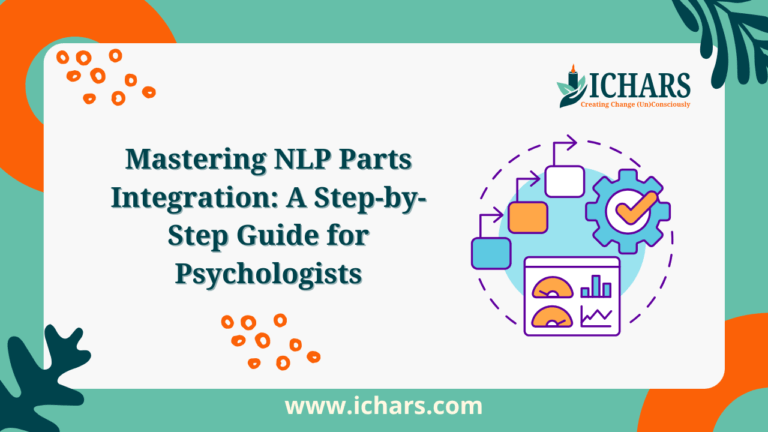Introduction: The Key to Unlocking Inner Harmony in Therapy
In every psychologist’s practice, there’s a recurring theme: clients caught in the grip of inner conflict. These conflicts aren’t always visible on the surface, but beneath the surface, two or more parts of the client’s subconscious mind are pulling them in different directions.
One part craves success, while the other fears failure. One part yearns for love, yet another part is terrified of vulnerability.
As a therapist, this dynamic can feel like you’re trying to guide a person who is simultaneously running toward their goals and pulling away from them—trapped in a cycle of self-sabotage.
And while traditional approaches might help, many therapists find that something deeper is needed to resolve these internal contradictions: NLP Parts Integration.
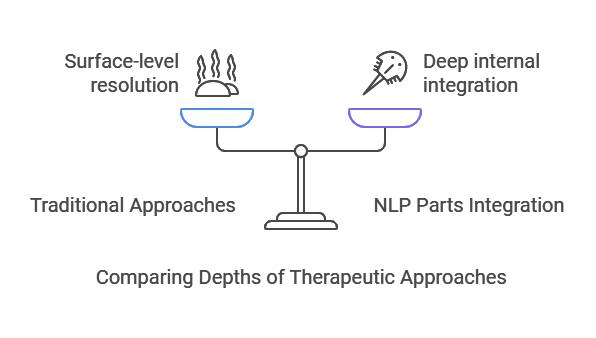
What is the NLP Parts Integration?
NLP Parts Integration is an advanced technique that facilitates profound psychological healing by harmonizing conflicting aspects of a person’s subconscious mind.
It’s not merely about addressing symptoms; it’s about helping clients achieve lasting integration of their fragmented selves, unlocking deep transformation.
This article will explore NLP Parts Integration in great depth, not just as a technique, but as a holistic psychological framework. We will look at its profound impact on your clients, the deeper psychological mechanisms at play, and the most advanced strategies for applying this transformative tool.
You can also watch a demonstration video to see NLP Parts Integration in action:
The Theory Behind NLP Parts Integration: Why It Works
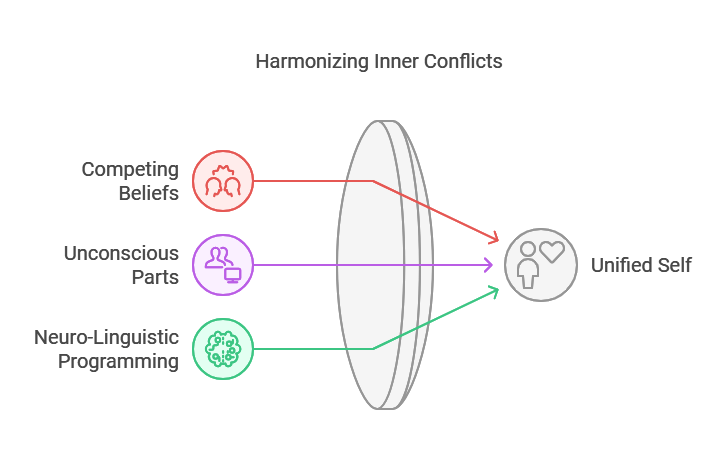
NLP Parts Integration is rooted in Neuro-Linguistic Programming, a system that maps how humans perceive and interact with the world. The basic idea is that individuals often experience internal conflicts because different aspects or “parts” of their psyche hold competing beliefs or desires.
These parts may be unconscious but are powerful in their ability to shape behavior, emotions, and decisions.
What Are These Parts?
In the context of NLP, “parts” are not physical entities, but rather mental or emotional fragments of the self. These parts may represent core values, desires, fears, or unresolved trauma.
Importantly, these parts are often not in direct opposition but are misunderstood. One part may be trying to protect the individual (e.g., the part avoiding risk to maintain safety), while another is attempting to move the individual toward success and fulfillment.
The primary challenge in therapy is that these parts often fail to communicate with each other. When parts conflict, clients experience emotional turmoil, mental confusion, and even physical discomfort.
This technique works by bringing these parts together, helping them understand and cooperate in achieving a common goal.
Why NLP Parts Integration Technique Works?
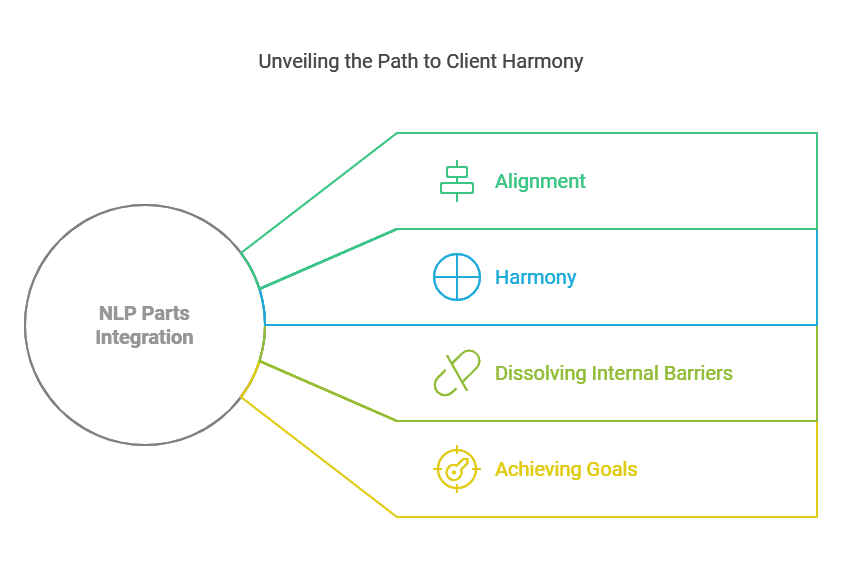
At its heart, this technique taps into the subconscious, which governs most human behavior. By guiding the parts toward a collaborative relationship, you help clients break free from internal contradictions, leading to alignment and harmony.
This process dissolves internal barriers, allowing clients to take meaningful steps toward their goals without sabotaging themselves.
Step 1: Identifying Conflicting Parts—An Intuitive Exploration
The first and most critical step in the NLP Parts Integration process is identifying the conflicting parts of the client’s psyche. This may sound straightforward, but uncovering these parts requires an attuned and empathic approach.
In traditional therapy, identifying emotional or behavioral patterns can be difficult for clients, especially if these parts are deeply buried in their subconscious. In NLP, we take a more experiential approach to identify these parts.
Advanced Techniques for Uncovering Parts:
- Somatic Awareness Techniques
The body is an excellent indicator of where inner conflict resides. Often, clients will experience tension, tightness, or discomfort in specific areas of their body when certain emotions or conflicts arise.
Guide your clients to engage in an emotional body scan: have them focus on each part of their body and notice where tension or resistance is felt. These sensations are often tied to the conflicting parts that are at odds with one another. - Metaphoric Language
Clients may not have the words to describe their inner conflicts directly, but they can often use metaphors or symbolic language to describe these parts.
By asking open-ended questions such as “If this part had a shape or color, what would it look like?” you invite the client to give form to their internal conflict.
This metaphorical representation helps the client begin to visualize the part in a way that makes the conflict tangible and approachable. - Inner Dialogue Exercises
Some clients are unaware of their internal conflict. To bring these parts into awareness, have them engage in an inner dialogue: “Ask the part that wants success how it feels about the part that fears failure. Let each part speak its truth without judgment.”
By giving each part a voice, you begin to illuminate the conflict, creating the space for resolution.
Step 2: Unveiling Positive Intentions—The Heart of Transformation
Once conflicting parts are identified, the next phase is one of deep discovery – uncovering the positive intentions behind each part. This is where the real magic of NLP Parts Integration occurs.
Each part is not “bad” or “destructive”; instead, it has a positive intention to protect or help the client in some way. This is often where breakthroughs occur.
Why Positive Intentions Matter:
Clients often view conflicting parts as enemies—one part wanting success while the other fears it.
But when clients understand that each part’s ultimate goal is positive (even if misguided), the tension between these parts begins to dissipate.
This shift in perspective is often profound and allows the client to view their internal world in a new, compassionate light.
Advanced Techniques for Uncovering Positive Intentions:
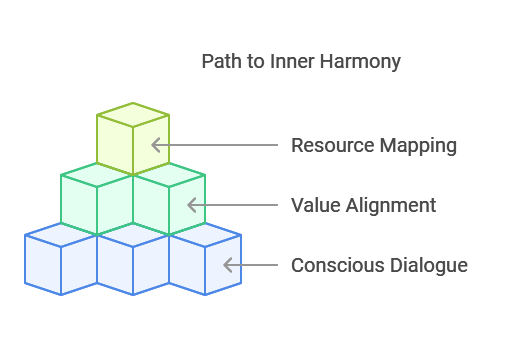
- Conscious Exploration Through Dialogue
Encourage your client to ask each part directly: “What are you trying to achieve? What is your ultimate goal?” Each part will provide insights into its motivation.
For example, the part avoiding risk may be trying to protect the client from failure or embarrassment, while the part pushing for success may be seeking recognition or fulfillment. When both parts are able to articulate their positive intentions, the foundation for integration is set. - Value Alignment
Each part of the psyche is typically rooted in one of the core values that the client holds dear. Ask your client to reflect on their values (e.g., safety, growth, connection) and assess how each part serves these values.
This not only helps the client understand why these parts exist but also allows them to see that both parts are attempting to serve the same overarching goal—whether it’s safety, personal growth, or fulfillment. - Inner Resource Mapping
Often, the issue is not that the parts are in conflict but that they believe there are limited resources (time, energy, etc.).
Use techniques such as resource mapping to help the client identify how these parts can share resources and work toward a common goal. This approach fosters collaboration rather than competition between the parts.
Step 3: Integrating Conflicting Parts—The Shift Toward Wholeness
Integration is where the real therapeutic transformation happens. After uncovering the positive intentions of the conflicting parts, you help your client create an internal dialogue between the parts, guiding them toward cooperation and alignment.
The process of integration involves more than simply “getting the parts to agree.” It’s about unifying them in a way that feels whole, balanced, and sustainable.
Advanced Techniques for Effective Integration:
- Physical Integration
Encourage the client to embody the integration process by physically bringing the conflicting parts together. For example, have them join their hands or close their eyes and imagine these parts merging into a unified whole.
This physical manifestation of integration helps ground the emotional and mental shift into the body, reinforcing the change at a somatic level. - Ecology Check and Future Assessment
After integration, ask the client to perform an ecology check: “Is there anything in your life that could be negatively affected by these parts working together?”
This ensures that the integration is not only beneficial but that it supports the client’s overall well-being. It’s also essential to check how the integration will impact the future.
Clients should feel empowered to take new, positive steps forward, knowing that their integrated self is aligned with their desires and goals.
Step 4: Future Projection—Empowering Clients to Live Their New Reality
Finally, once the parts are integrated, it’s time to project the newly integrated self into the future. This step is about solidifying the changes in the client’s psyche and ensuring that the integration becomes part of their future actions.
Advanced Techniques for Future Projection:
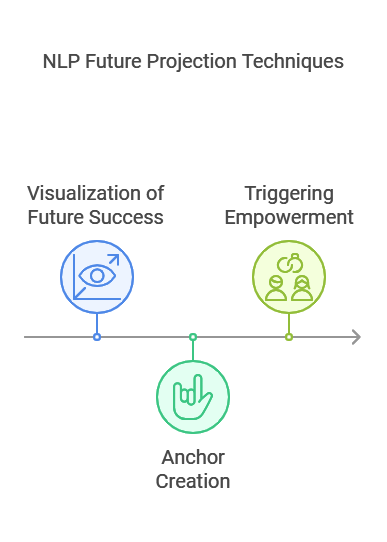
- Rewriting the Future
Use visualization techniques to help clients project their newly integrated self into the future. Ask them to imagine a specific situation where they previously felt conflicted and guide them in visualizing how they would handle it now with the integration complete.
This not only reinforces the change but also prepares them for success in real-life scenarios. - Behavioral Anchoring
Once the client has visualized their future success, anchor that feeling by associating it with a specific gesture or phrase.
This allows the client to trigger the feelings of alignment and empowerment whenever needed, reinforcing the integration in everyday life.
Why NLP Parts Integration is Essential for Psychologists
NLP Parts Integration is a tool that can create transformative change in your practice. It goes beyond symptom management, addressing the root causes of conflict and guiding clients toward deeper alignment with their core values and desires.
- Lasting Change: NLP Parts Integration doesn’t just solve problems; it eliminates the root causes of internal conflict, leading to long-term transformation.
- Holistic Healing: The integration process addresses the whole person—emotionally, cognitively, and somatically—creating a unified self.
- Enhanced Effectiveness: Whether you’re working with trauma, anxiety, or self-sabotage, NLP Parts Integration provides a comprehensive framework for resolving deep-seated issues.
Conclusion: Unlock the Power of NLP Parts Integration in Your Practice
NLP Parts Integration is a powerful tool for psychologists who want to help clients resolve inner conflict, achieve deeper self-awareness, and create lasting change.
Through advanced techniques for identifying, understanding, and integrating conflicting parts, you can facilitate profound healing and transformation.
If you’re ready to master NLP Parts Integration and other advanced therapeutic techniques, consider enrolling in our Cognitive Hypnotic Psychotherapy Diploma.
This program is designed for professionals like you who want to elevate their practice and make a real difference in their clients’ lives.
